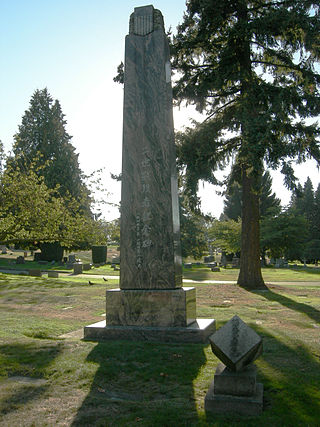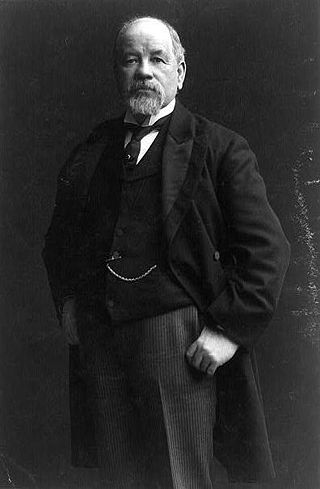
Bothell is a city in King and Snohomish counties in the U.S. state of Washington. It is part of the Seattle metropolitan area, situated near the northeast end of Lake Washington in the Eastside region. It had a population of 48,161 residents as of the 2020 census.

State Route 99 (SR 99), also known as the Pacific Highway, is a state highway in the Seattle metropolitan area, part of the U.S. state of Washington. It runs 49 miles (79 km) from Fife to Everett, passing through the cities of Federal Way, SeaTac, Seattle, Shoreline, and Lynnwood. The route primarily follows arterial streets, including Aurora Avenue, and has several freeway segments, including the tolled SR 99 Tunnel in Downtown Seattle. SR 99 was officially named the William P. Stewart Memorial Highway by the state legislature in 2016, after a campaign to replace an unofficial moniker honoring Confederate president Jefferson Davis.

Lake View Cemetery is a private cemetery located in Seattle, Washington, in the Capitol Hill neighborhood, just north of Volunteer Park. Known as "Seattle's Pioneer Cemetery," it is run by an independent, non-profit association. It was founded in 1872 as the Seattle Masonic Cemetery and later renamed for its view of Lake Washington to the east.

Volunteer Park is a 48.3-acre (19.5 ha) park in the Capitol Hill neighborhood of Seattle, Washington, United States.

Licton Springs or North College Park is a neighborhood in the informal Northgate district of North Seattle. It is bounded by Interstate 5 to the east, beyond which is Maple Leaf neighborhood and the Northgate Mall; Aurora Avenue N to the west, beyond which is Greenwood; N 85th Street to the south, beyond which is Green Lake, and N Northgate Way to the north, beyond which is Haller Lake.
Evergreen Cemetery may refer to the following cemeteries in the United States :

Thomas Burke was an American lawyer, railroad builder, and judge who made his career in Seattle, Washington. He served as chief justice of the Supreme Court of the Washington Territory from 1888 to 1889. He was the main representative of railroad magnate James J. Hill in Seattle. Burke Avenue, The Burke-Gilman Trail and the Burke Museum are named in his honor.

Watson Carvosso Squire was an American Civil War veteran, twelfth governor of Washington Territory, and United States Senator from the state of Washington.

Cheshiahud and his family on Lake Union, Seattle, Washington, in the 1880s are, along with Princess Angeline, among the few late-19th century Dkhw'Duw'Absh about whom a little is known. In the University of Washington (UW) Library image archives, he is called Chudups John or Lake Union John. His family were among the few of the Duwamish people who did not move from Seattle to the Port Madison Reservation or other reservations. They lived on Portage Bay, part of Lake Union, when a photo was taken around 1885. According to the Duwamish Tribe, Lake John had a cabin and potato patch at the foot of Shelby Street. A commemorative plaque of unknown reliability is said to exist at the eastern foot of Shelby. This land was given to him by Seattle pioneer David Denny or the property was purchased—see below. Photographer Orion O. Denny recorded Old Tom and Madeline, c. 1904, further noted in the UW Library archives as Madeline and Old John, also known as Indian John or Cheshishon, who had a house on Portage Bay in the 1900s, south of what is now the UW campus although native people had been prohibited from residence in Seattle since the mid-1860s.
Lawrence Denny Lindsley was an American scenic photographer and also worked as a miner, hunter, and guide. Lindsley was a grandson of Seattle pioneer David Thomas Denny (1832–1903).

David Thomas Denny was a member of the Denny Party, who are generally collectively credited as the founders of Seattle, Washington, United States. Though he ultimately underwent bankruptcy, he was a significant contributor to the shape of the city. Roger Sale, in his book Seattle, Past to Present, described him as having been "the pioneer to turn to if one had a plan that would be 'good for Seattle', and one needed a respectable tone and a willing investor."
Brenden Stephen Foster was an 11-year-old boy from Bothell, Washington, diagnosed with acute lymphoblastic leukemia in 2005. KOMO, a local broadcasting station, reported the story of Brenden's last wish on November 7, 2008, which was to feed the homeless. The story inspired many, and prompted attention from national media such as CNN and the Associated Press, even drawing international attention.

Alonzo Victor Lewis (1886–1946) was an American artist. He is primarily known for public sculptures in the State of Washington; he also painted in the Impressionist style.

Benjamin M. Paris was an American sportsman, entrepreneur, conservationist, and owner of a landmark restaurant in Seattle, Washington. Paris founded the Seattle Ben Paris Salmon Derby. He is inurned at the columbarium at Evergreen Washelli Memorial Park.
Benjiman I. William Fey was an American movie theatre owner.

Bothell Pioneer Cemetery is a cemetery located in Bothell, Washington.

Emily Inez Denny was a painter who drew scenes from Seattle's early history, along with landscapes of the Puget Sound region. Her parents were Seattle pioneers David Denny (1832-1903) and Louisa Boren Denny (1827-1916). Her parents came to Seattle from Cherry Grove, Illinois over the Oregon Trail. Emily had a sister, Abbie Denny Lindsley (1858-1915), and two brothers, D.T. Denny and Victor Denny.

American Doughboy Bringing Home Victory, also known as Armistice and Spirit of the American Doughboy, is an outdoor 1932 bronze sculpture and war memorial by Alonzo Victor Lewis. The statue is 12.0 feet (3.7 m) tall and weighs 4,600 pounds (2,100 kg).



















